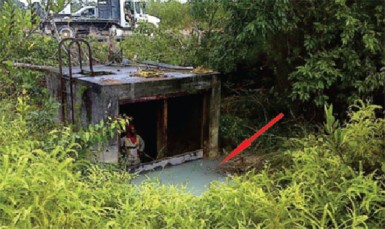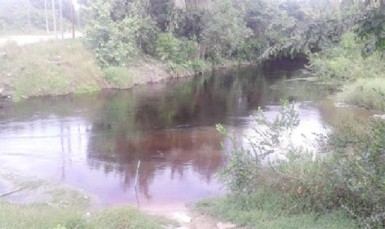The Environmental Protec-tion Agency (EPA) will intensify the monitoring of Bosai Minerals Group (Guyana) Inc’s (BMGGI) tailings discharge into the Kara Kara Creek after the Chinese company’s tailings pond overflowed last month and caused pollution of the waterway.
The pollution has since been dealt with, according to a statement from the Ministry of Natural Resources and the Environment. It recounted that in relation to turbid tailings discharge entering the Kara Kara Creek at Kara Kara Bridge it was observed downstream that the discharge revealed dilution. Water quality assessment of turbidity levels at the discharge point was found to be 288 NTU while downstream of the discharge point it was 13.9 NTU and upstream of the discharge point turbidity was 2.44 NTU.
Turbidity refers to a measure of the amount of light that passes through water. Heavy suspended and dissolved sediments present in water often result in a murky appearance. Therefore, the more sediment particles present in a water body, the murkier the water will appear. Guyana’s Mining (Amend-ment) Regulations 2005 stipulate that tailings water can be discharged into a river or creek once it meets the turbidity of less than 50 NTU, the ministry noted.

The statement said that representatives of BMGGI indicated that the turbid discharge was as a result of increased and a direct flow of tailings to the Decant Tower just above the Kara Kara bridge. Tailings discharge from the wash plant is normally released into the tailings pond, and natural flow would channel the tailings through vegetation around the eastern perimeter of the tailings pond, it noted.
“This path allows for natural filtration of the sediments, following which, the water flows to the Decant Tower, where further settling occurs before flowing into the Kara Kara Creek. The Decant Tower has an overflow barrier that allows for settling of sediments,” the statement said.
It said that the EPA team observed that this was in a dilapidated state and this, coupled with the increased flow to the Decant Tower, prevented any effective settling of the tailings discharge. The ministry said that the increased flow was attributed to above normal rainfall in the area a few days prior to the reported event.

The statement said that the increased rainfall in the area was confirmed by the Hydrometeorological Department records which indicated above normal rainfall in the area reaching a total of 15mm on January 23 and 24.
The ministry said that BMGGI’s representatives informed the EPA team that they diverted the tailings flow south in the tailings pond to allow it to filter over a larger area. In addition they were preparing to conduct remedial works on the Decant Tower and build a dyke upstream of the tower to stop the turbid direct flow into the Kara Kara Creek. They had also stopped discharging from the wash plant. Assessment of the Turbidity levels in the Kara Kara Creek later into the night (by EPA) revealed a gradual decrease from 288 NTU to 88.9 NTU, the ministry said.
It added that the EPA team immediately instructed BMGGI’s representatives to cease operation of the wash plant and tailings discharge, and to ensure the remedial measures to prevent further contamination are put into place.
“On January 30th, 2014 the Agency confirmed that the remedial works were completed with the exception of the dyke. However, resumption of tailings discharge was allowed and the turbidity levels were monitored and found to be below the acceptable level of 50 NTU. Turbidity in the Kara Kara Creek at the point of the tailings discharge returned to normal,” the statement said.
It added that the Agency further advised BMGGI to increase the frequency of monitoring and reporting on water quality of the tailings discharge, including ground and other surface waters in and around the operation and mine sites.

The statement said that the ministry has mandated the EPA to intensify the monitoring of BMGGI tailings discharge into the Kara Kara Creek.
It said that last year, in an effort to strengthen monitoring and enforcement, the Ministry formed the Environmental Management Compliance and Enforcement Division (EMCED). This new Division will ensure compliance with and enforce the provisions of the EPA Act and associated regulations. It will do this by monitoring and determining the level of compliance.
Where there are breaches and non-compliance with the EPA Act and regulations, the Division will objectively and assertively take measures to ensure offenders cease the non-compliant activity and/or fix any harm to the environment and, where appropriate, apply a penalty or sanction. Compliance and enforcement will be supported by provision of advice, guidance and building partnerships to ensure duty-holders understand what compliance is and how to identify and manage the risks of their activities, the statement said.
It added that the EMCED conducted several compliance inspections of BMGGI’s Operations during 2013. Inspections targeted the company’s compliance with its Environmental Permit, specifically Mining Operations, Waste Management, and Water Quality monitoring, among other areas, the ministry said. “BMGGI is required to monitor ground and surface water for turbidity, suspended solids, and heavy metals, in and around its operations. The Agency also noticed in the media concerns about the effective functioning of BMGGI’s Kilns 13 and 14. Our compliance inspections confirmed that dust collection systems were installed on kilns 13 and 14. This is evident by consistent clean emissions from the chimneys of these kilns. An air quality monitoring protocol has been developed for BMGGI and the Agency will be implementing same during the first quarter of 2014,” it added.








